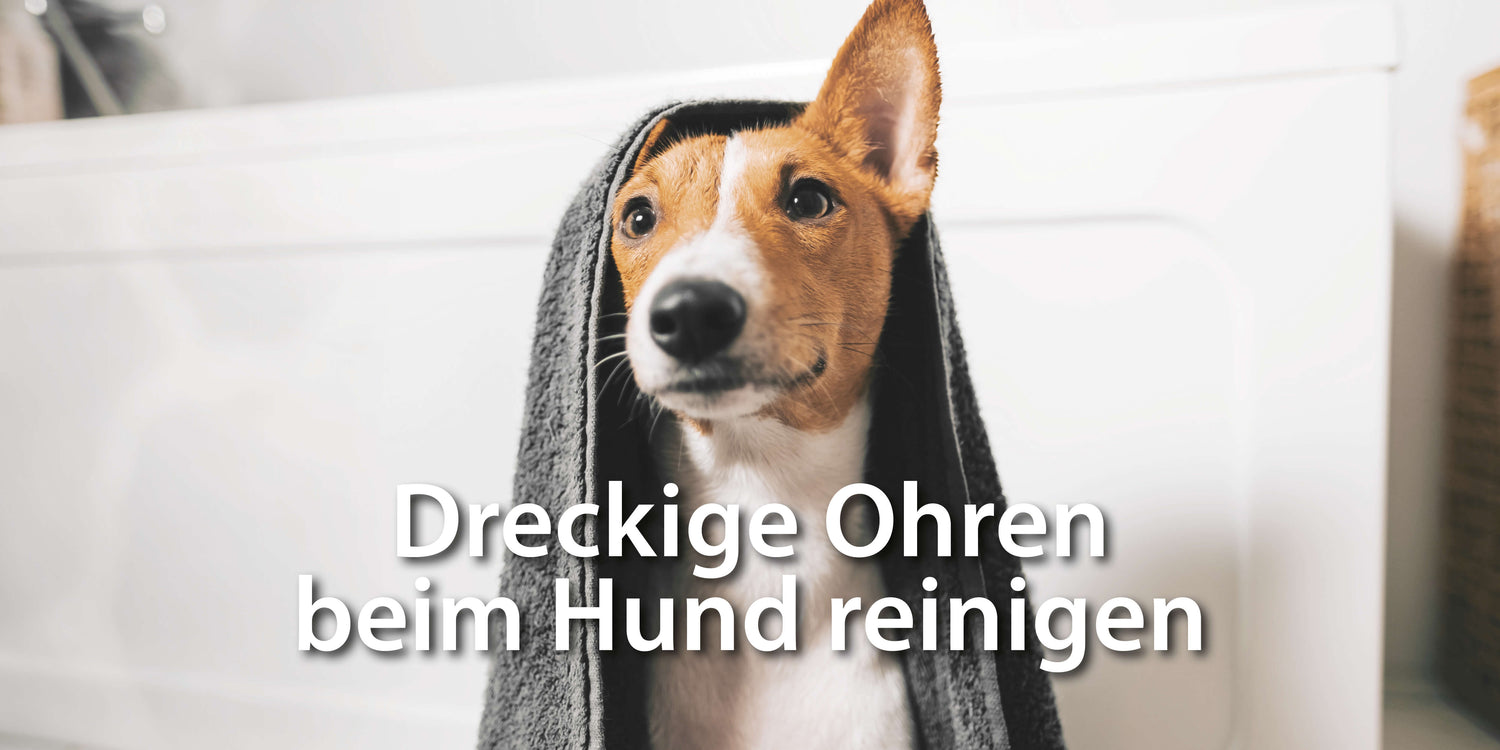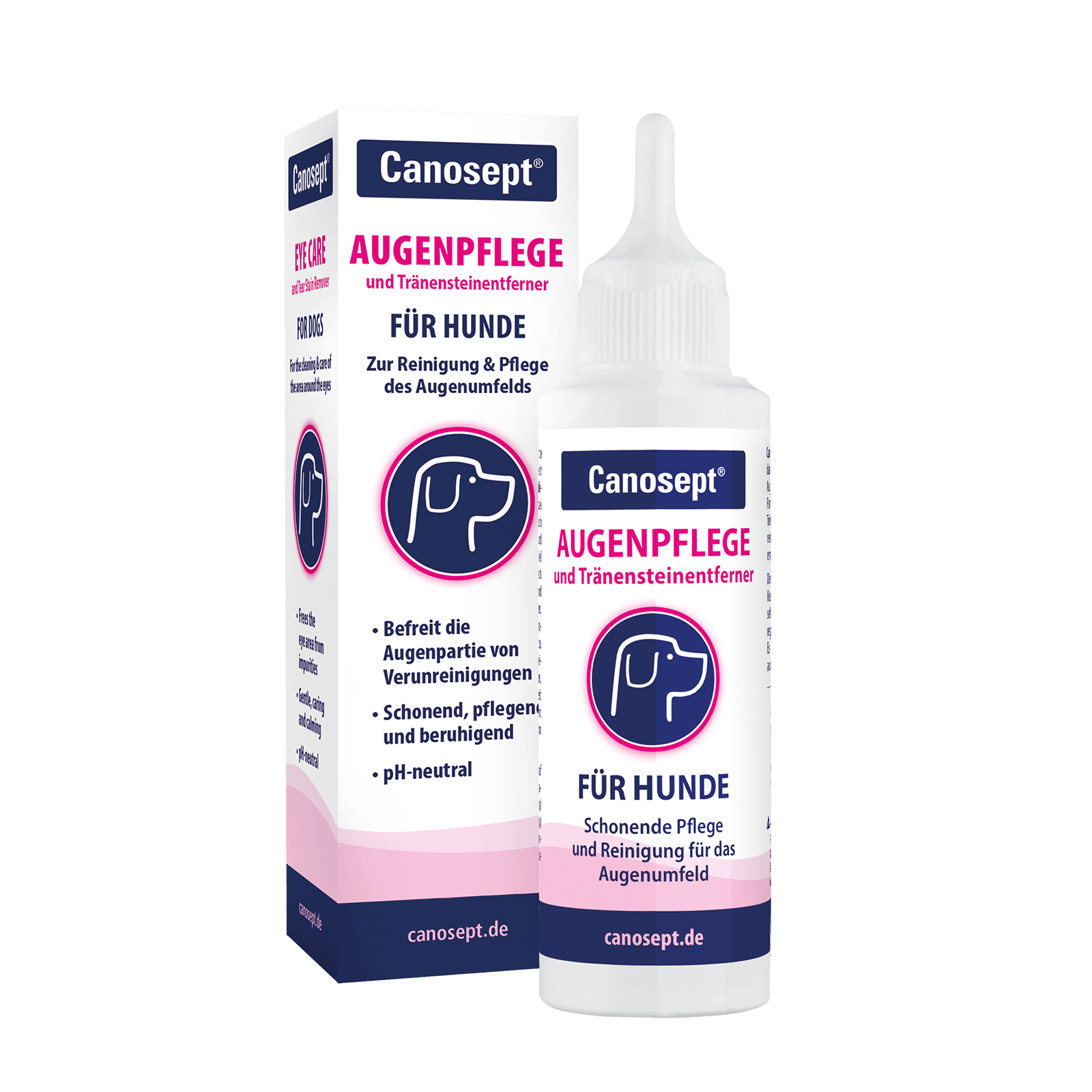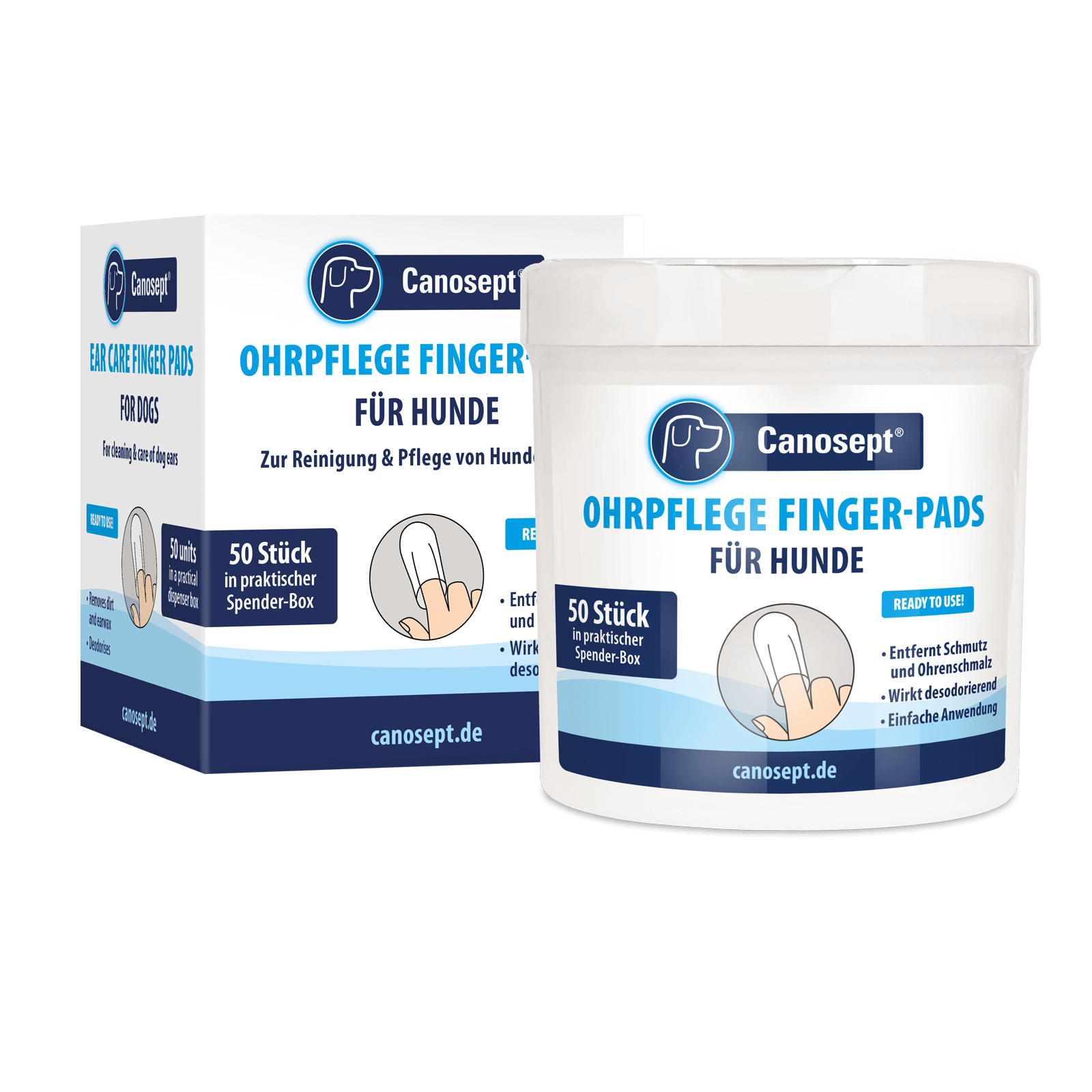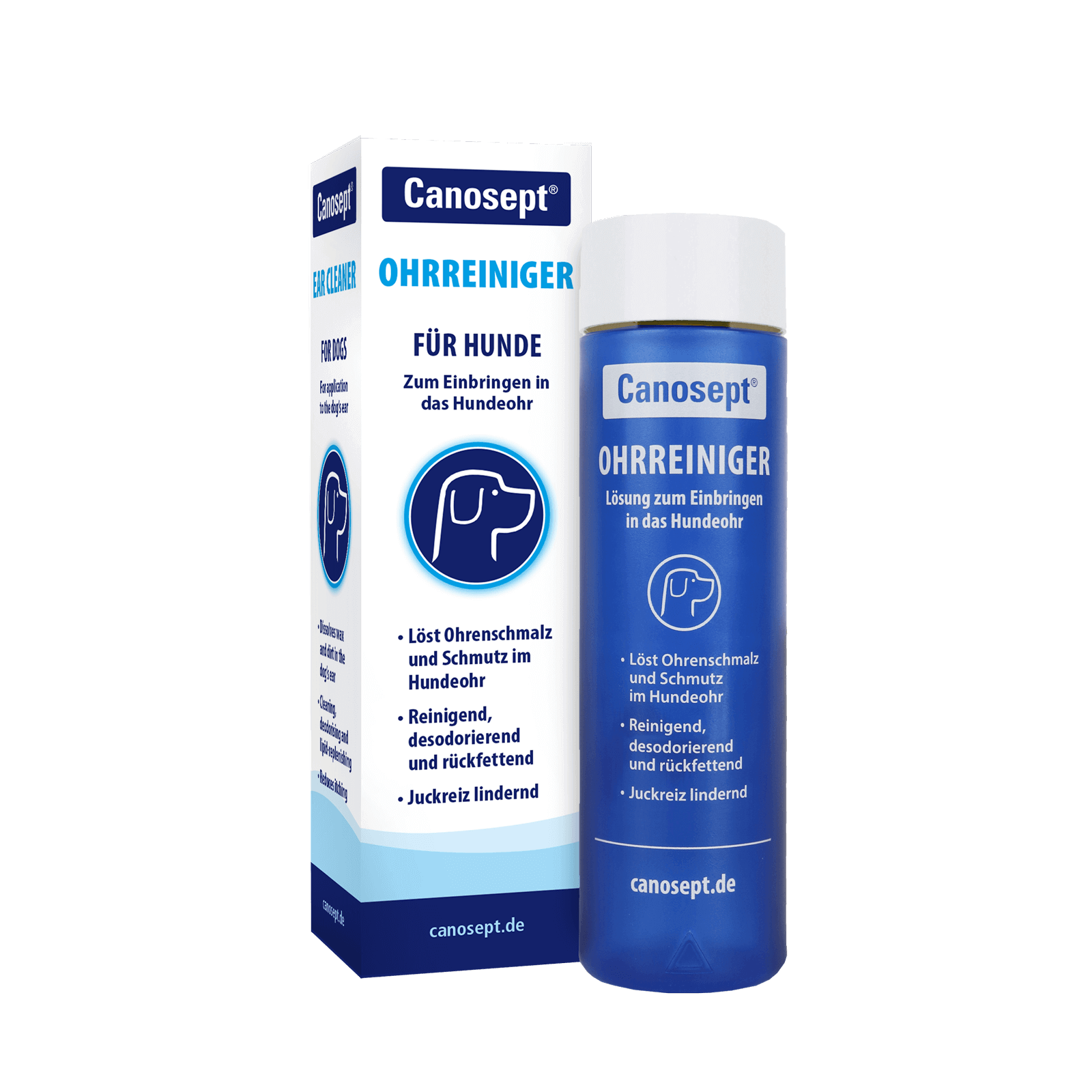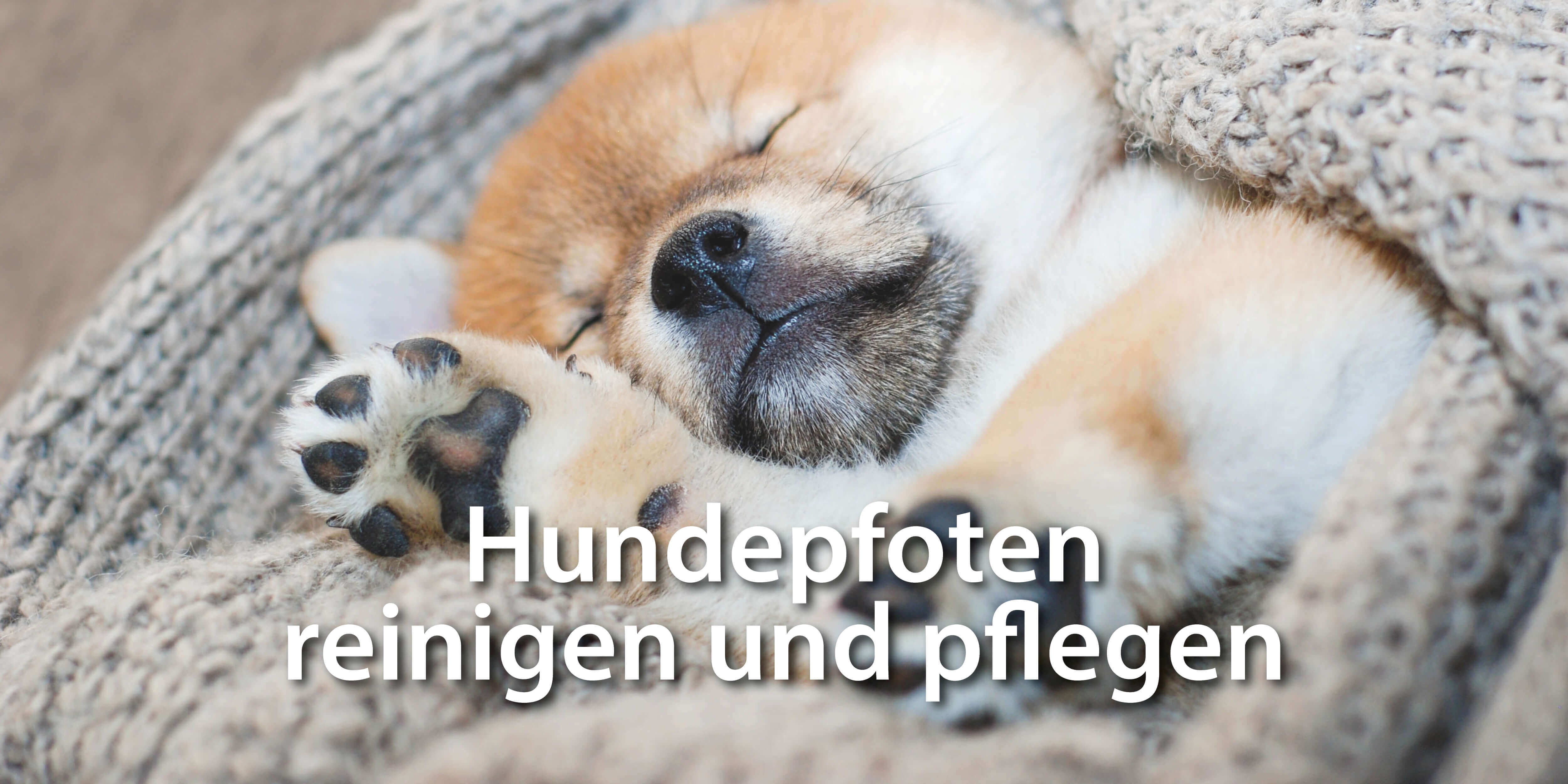- Why should I clean my dog's ears?
- Anatomy of the dog ear
- How often do I need to clean my dog's ears?
- Step-by-step instructions for ear cleaning
- Home remedies for cleaning dog ears
- Preventive measures against ear problems
- Ear problems in dogs
- When is a visit to the vet necessary?
- Conclusion

Why should I clean my dog's ears?
A dog's ear usually has functioning self-cleaning mechanisms. The sebaceous and sweat glands in the external auditory canal produce earwax to remove dirt particles, dead skin cells, and hair. The protective hairs also ensure the health of these sensitive sensory organs.
However, dog ears have changed significantly over the course of evolution. Today, there are many different ear shapes. This means that the self-cleaning mechanisms are no longer sufficient . Cleaning your dog's ears helps remove excess wax, dirt, and debris that accumulate in the ear canals. For this reason, your dog should be accustomed to having his ears touched, cleaned, and checked from a young age.
Should you clean dog ears?
Yes! This can prevent infections, inflammation, parasites, and bad odors. Dog parents should therefore regularly clean the ear canal and the ear canal.Anatomy of the dog ear
A dog's ear is naturally very well developed . This is necessary, as hearing is a dog's most important sense organ. Seventeen ear muscles enable dogs to hear in three dimensions. This allows them to sense their environment aurally, rotating their ears independently of each other.
Furthermore, dogs can hear sounds in a frequency range of 15–60,000 hertz. This range includes sounds in the ultrasonic range, such as the squeaking of mice or the cry of a bat. For comparison, humans hear sounds between 20–20,000 hertz. (Source: GEERS )
The different parts of the ear and their functions
The dog's ear receives sound waves and vibrations. These sounds and noises are then transmitted to the brain in the form of impulses. After comparison with information from the other sensory organs, the dog's behavior is ultimately influenced. The dog's ear consists of the outer ear, the middle ear, and the inner ear .

The outer ear
The outer ear consists of the auricle, the external auditory canal, and the eardrum . Sound waves are transmitted through the auricle to the eardrum. Depending on the breed, the shape of the auricle varies as follows:
- Short, erect ears
- Long, erect ears
- bat ears
- tilt ears
- rose ears
- Droopy ears
- Extra-long drooping ears
Earwax, which plays an important role in the self-cleaning of the dog's ear, is produced in the external auditory canal. The eardrum, a membranous membrane, separates the outer ear from the middle ear.
The middle ear
The middle ear contains the auditory ossicles, namely the hammer, anvil, and stapes. The middle ear itself is a cavity filled with air and lined with mucus. Because it is connected to the pharynx via the Eustachian tube, it functions to equalize pressure .
The inner ear
The inner ear contains the hearing organ, a membranous labyrinth filled with lymph fluid. Sound waves are transported through this labyrinth to the auditory cells. They are then converted into electrical impulses and transmitted to the brain via the auditory nerve.
The vestibular system, which transmits information about movement and body position to the brain, is also located in the inner ear. (Source: Petdoctors )

Why are certain dog breeds more prone to ear problems?
Dog breeds with heavily overhanging and bent ears are particularly prone to ear problems. Natural ventilation is poor in these dogs. In very hairy ears, the hair can clog the ear canal. On the other hand, bent ears usually have a narrow ear canal, which is easy for dirt and pathogens to accumulate. This creates a warm, humid environment, which is ideal for germs, fungi, and bacteria.
How often do I need to clean my dog's ears?
For healthy dog ears, cleaning the auricle and ear canal once or twice a week is sufficient. Depending on the dog's breed, age, general health, and environment, the frequency can be adjusted individually.
Step-by-step instructions for ear cleaning
Now that you've answered why you should clean your dog's ears, what's the best way to go about it?
Step 1: Examine the ear for signs of infection or injury
A healthy dog's ear is clean, odor-free, pink in color, and has minimal earwax buildup. There are also no sores, thickenings, or swellings.
Ear checks are important for early detection of signs of disease . Long-haired dogs with floppy or droopy ears in particular should be checked for foreign bodies in or on their ears after every walk.

Step 2: Choosing the right cleaning agent
Dogs' ears are very sensitive. Choosing the right cleaning product is all the more important. When cleaning the ear canal, it's important to use mild ear cleaners specifically developed for dogs . Liquid ear cleaners are particularly suitable, as they are best without a tip and are therefore particularly safe to use. Human products are too harsh for dogs' sensitive ears and should therefore not be used.
Dog parents should also use special ear cleaning pads to clean the ears. High-quality ingredients, such as aloe vera gel, provide additional care for your dog's ears.
What is the best ear cleaner for dogs?
The best ear cleaner for ear canal care and hygiene is Canosept Ear Cleaner . This not only removes dirt and earwax, but also gently cleanses the lower sections of the ear canal. For the auricle, we recommend using the directly insertable and specially shaped Canosept ear care finger pads .Step 3: Prepare the cleaning agent
The ear cleaner should be lukewarm . No further preparation is required for use with Canosept Ear Cleaner .
After application, the dog will shake itself to get rid of loosened dirt and excess product. Therefore, dog owners should ensure a suitable environment .
In addition, and before using the ear cleaner, you can remove coarse debris from the external ear canal for optimal results. We recommend the Canosept Ear Care Finger Pads for this purpose. Thanks to the specially developed finger pads, dog parents can intuitively follow the shape and movement of the dog's ear while cleaning.

Step 4: Applying the cleaning agent
The ear cleaner is then carefully dripped into the ear until a level of fluid is visible. For dogs with floppy or bent ears, simply hold the tip of the ear up. It's important to ensure the ear cleaner doesn't get into the eyes.
Step 5: Massaging the ear
Gently knead and massage the liquid into the outside of the dog's ear. This is the only way to loosen all dirt particles.
Ear massage offers two additional benefits. First, it strengthens the dog-human bond. Second, it also has a relaxing effect on dogs. This is due to the vagus nerve, which neurologically controls a large portion of the middle part of the dog's ear. Stimulation of this nerve has a calming effect on dogs.

Step 6: Remove dirt and fluid from the ear
After cleaning, dirt, wax, and fluid may have accumulated in the auricle. This can be quickly removed with a moist cotton pad or the Canosept Ear Care Finger Pads .
A soft towel can be used to dry the outside of the ears after cleaning.
Step 7: Reward your dog for behavior during cleaning
Reward your dog after cleaning his ears to make the experience more positive . This can be achieved with a long game or the occasional treat.
Home remedies for cleaning dog ears

There are some home remedies that are often used. But are they suitable, or should dog parents stay away?
cotton swabs
The use of cotton swabs for cleaning a dog's ear is clearly not recommended . As with humans, this often just pushes the earwax into the ear canal, where it then becomes trapped. The risk of the cotton swab coming off and clogging the ear canal is too great.
Chamomile tea & apple cider vinegar
Tinctures of chamomile tea or apple cider vinegar are said to loosen earwax in the ear canal. Apple cider vinegar is even said to have anti-inflammatory properties. However, to achieve these effects, the ideal mixing ratio is required. Veterinarian Prof. Dr. Norbert Mencke therefore advises against their use. The risk of the mixing ratio being inappropriate for this sensitive sensory organ is too high.
Oils
Baby oil, olive oil, coconut oil, walnut and almond oil—the list of oils that seem to be suitable for cleaning the ear canal and the outer ear could probably go on forever. For some dog parents, these seem to work.
However, especially with sensitive dog ears, it's important to play it safe. Therefore, dog parents should opt for products specifically developed for their dog's needs.
Preventive measures against ear problems
In addition to proper care and cleaning of the dog's ear, there are other preventative measures against ear problems.

Proper nutrition for ear health
An unhealthy diet can make a dog more likely to develop an ear infection. This is because the intestines have a major influence on a dog's health. If the intestinal flora becomes unbalanced, for example, due to an unhealthy diet, the dog's ear's natural protective mechanisms can be disrupted.
Dog parents should therefore ensure their dog has a balanced diet. This includes the right mix of proteins, fats, carbohydrates, minerals, trace elements, and vitamins (source: VDH ).
Protecting your dog's ears while bathing and swimming
No matter the body of water, many dogs enjoy bathing and swimming. After romping and playing in the water, dogs' ears should always be checked for debris and injuries and thoroughly dried. Moisture in the ears can lead to infections (source: Veterinary Medicine Portal ).
Ear problems in dogs
Ear problems in dogs are not to be taken lightly. The risk of an untreated infection or parasitic infestation causing long-term hearing damage is too high.
Signs and symptoms of ear problems
- Unpleasant smell
- Redness or swelling
- Accumulations of dark brown earwax
- Black or yellowish stains
- Noticeable scratching or rubbing
- Sensitivity to touch
- Frequent shaking of the head to one side
- Unusual behavior such as apathy or depression and apathy
- Hearing loss, balance disorders, disorientation
If dog parents discover black dirt in their dog's ears, this could be a sign of ear mites . The color can vary from dark brown to black.
The first sign of ear mites is frequent scratching of the ears and shaking of the head . This is due to the skin irritation and inflammatory reaction that occurs when mites are infested.

When is a visit to the vet necessary?
A visit to the vet should be made immediately as soon as dog parents notice signs or symptoms of ear problems, such as expressions of pain and resistance when the ears are touched and frequent, intense shaking of the head.
What the vet will do when examining your dog's ears
If there are signs of ear problems, the veterinarian will examine the ears with an otoscope. Often, a swab or sample will be taken afterward. Determining the exact cause is necessary to ensure the correct treatment. (Source: Claßen, J. & Müller, R. (2017) Otitis externa Kleintierpraxis 62)
But how much are the veterinary costs in this case? The detailed examination of individual organs, including the ear, nose, and throat area, is stipulated in the Veterinary Fee Schedule ( GOT ) (source: German Medical Association ).
Treatment options that the veterinarian can recommend
The treatment options are as varied as the ear problems themselves. For this reason, it is necessary to discuss individual treatment with your veterinarian.
8 preventative tips on how you can save money despite the veterinary fee regulations .
Conclusion
- To prevent infections, inflammation, parasites and bad odors, you should clean your dog's ears 1-2 times a week.
- Check your ears daily for dirt, odors, discoloration, and excess earwax. Also look for wounds, thickening, or swelling.
- When choosing a cleaning product, keep in mind that your dog's ear is a sensitive organ. Therefore, we recommend using specially formulated products, such as the Canosept Ear Cleaner for the ear canal and Canosept Ear Care Finger Pads for the auricle.
- Never use a cotton swab to clean your dog’s ear.
- Proper cleaning and care as well as a balanced diet can prevent ear problems.
- As soon as signs and symptoms of ear problems appear, consult your veterinarian. Only then can proper treatment be provided.

